Home >Directory of Drawing Lessons > How to Improve Your Drawings > Drawing What You See > Vision and Drawing
VISION and DRAWING : The Use of Your Eyes and Vision While Drawing Mass and Form with the Following Lesson
|
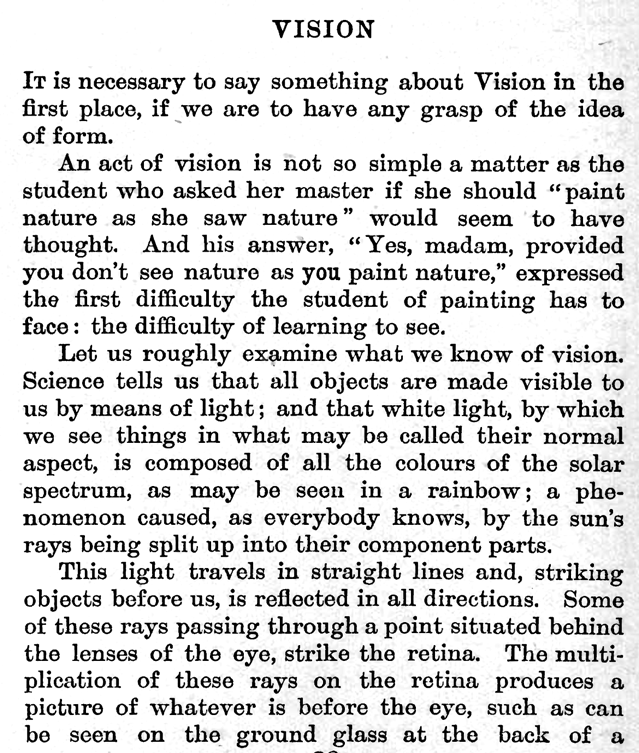
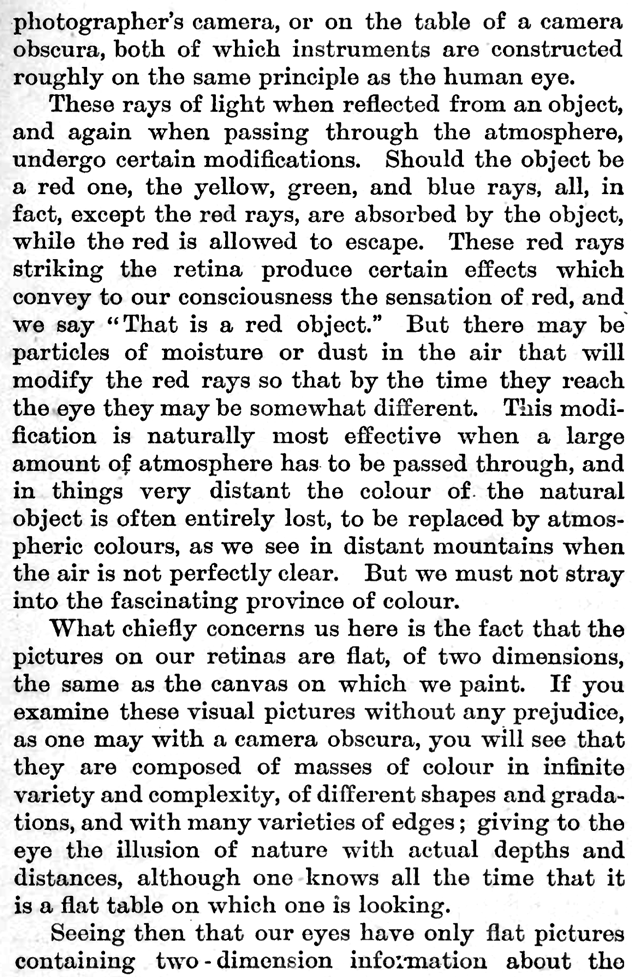
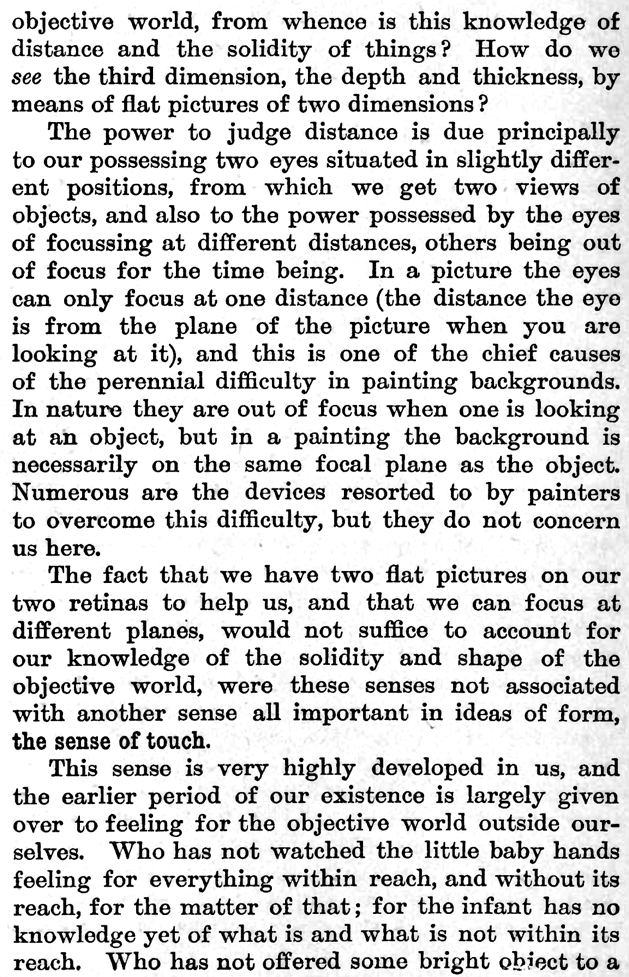
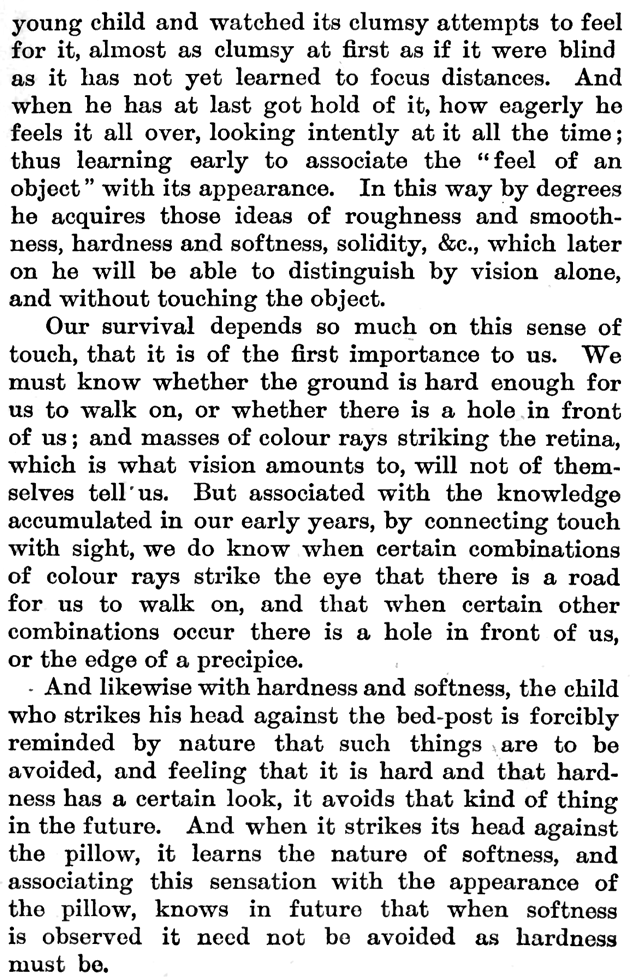
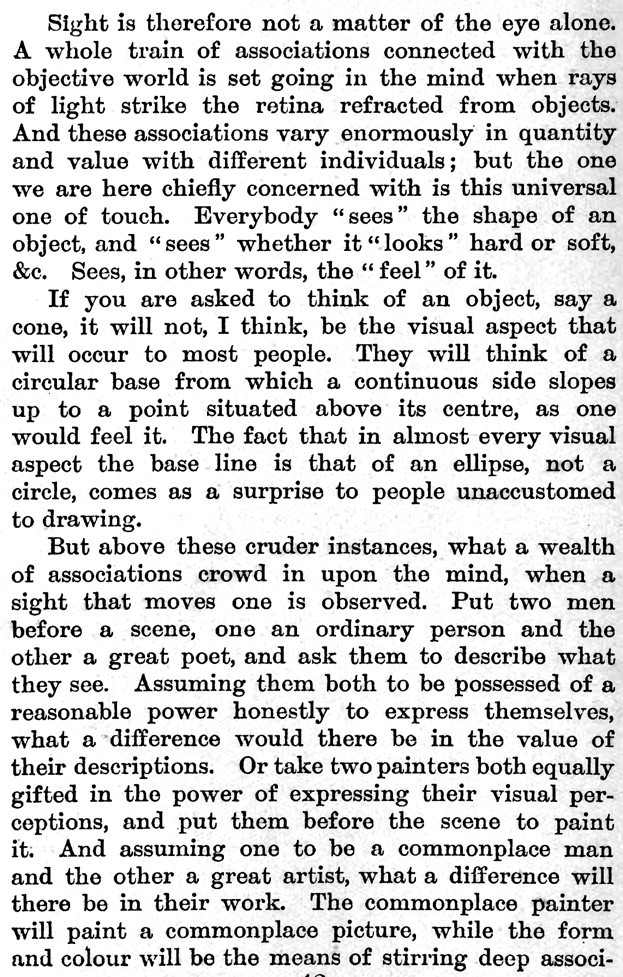
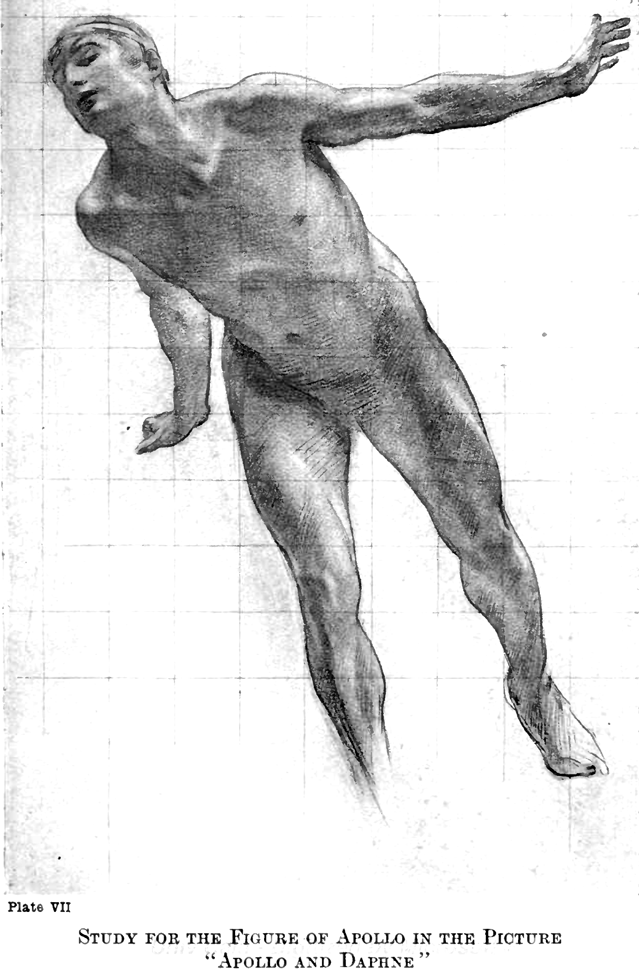
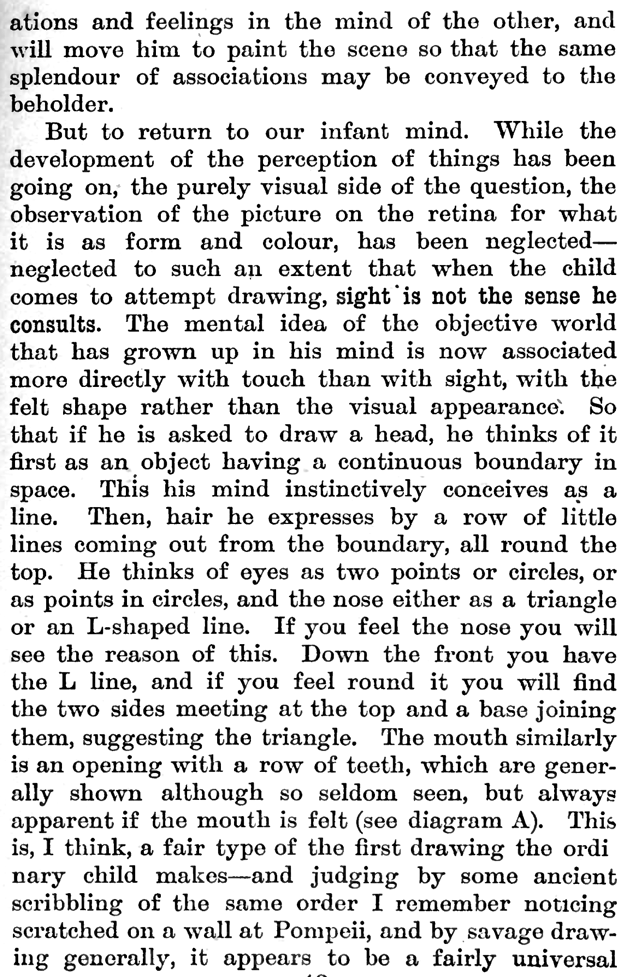
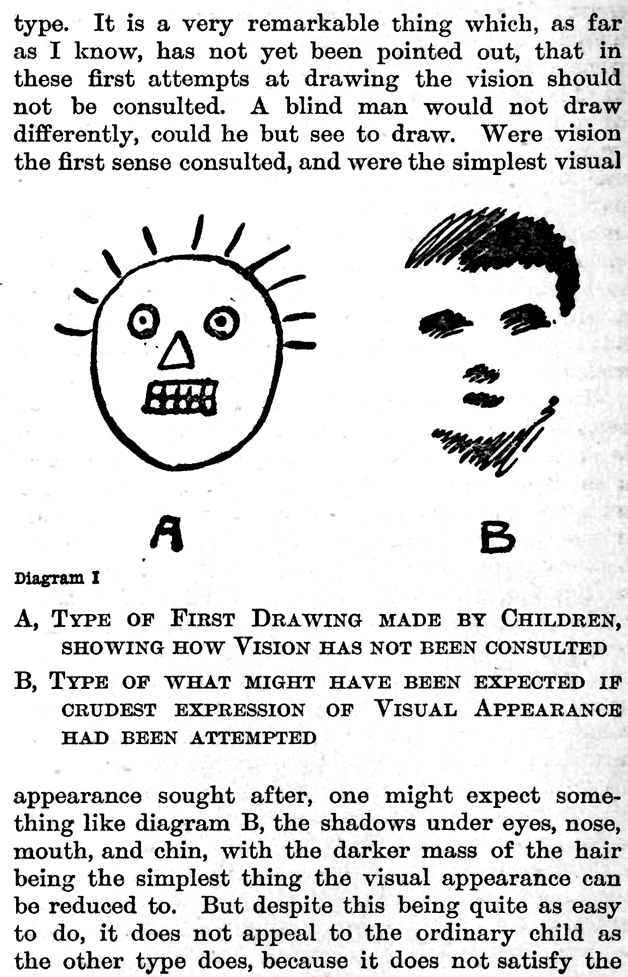
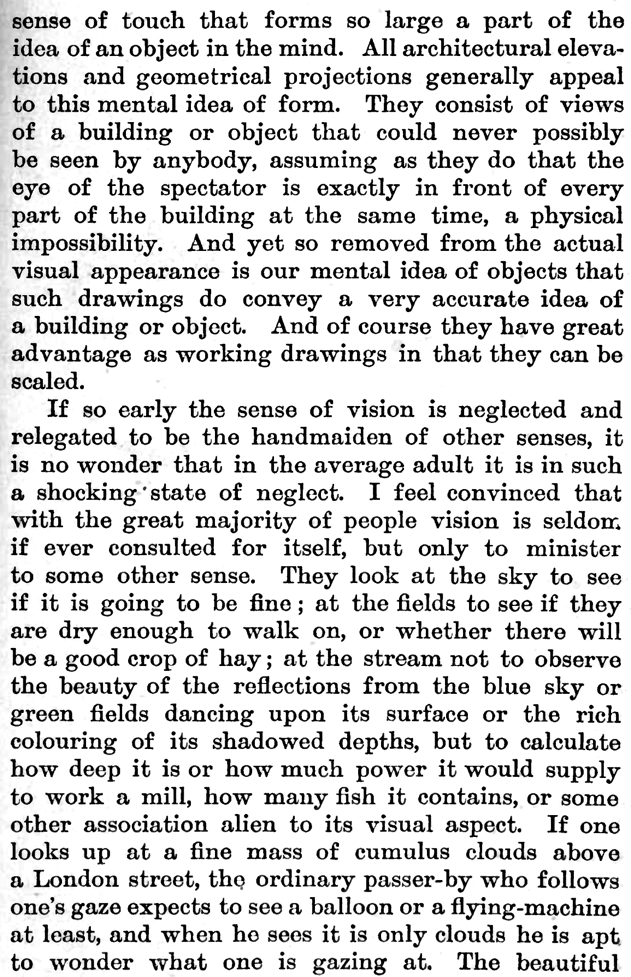
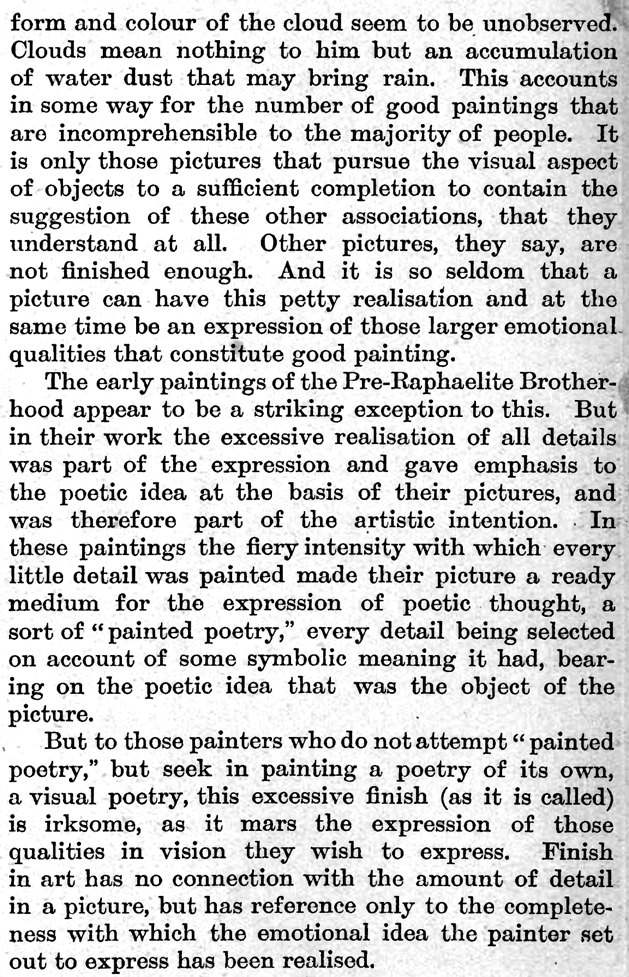
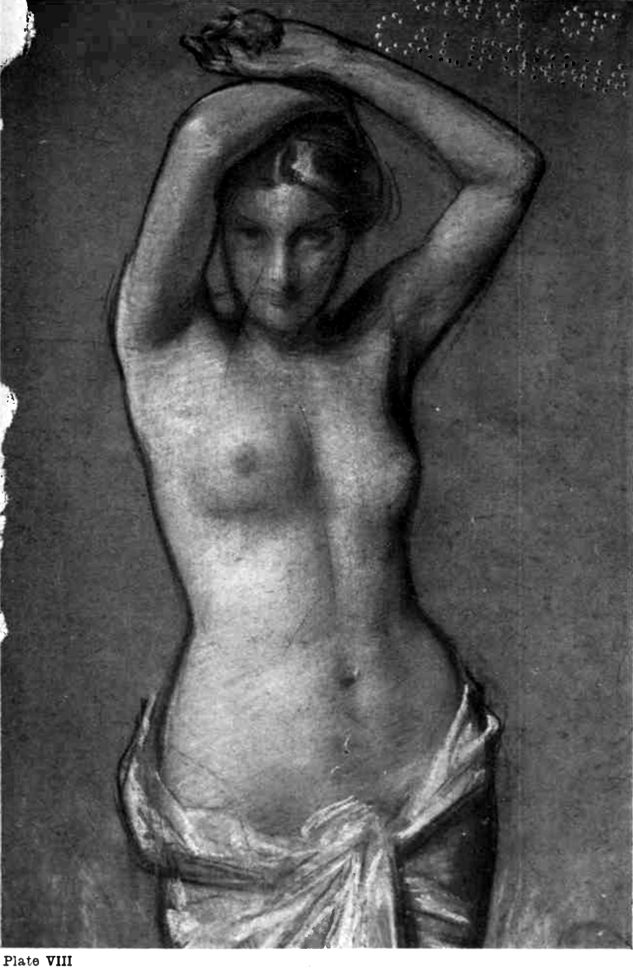
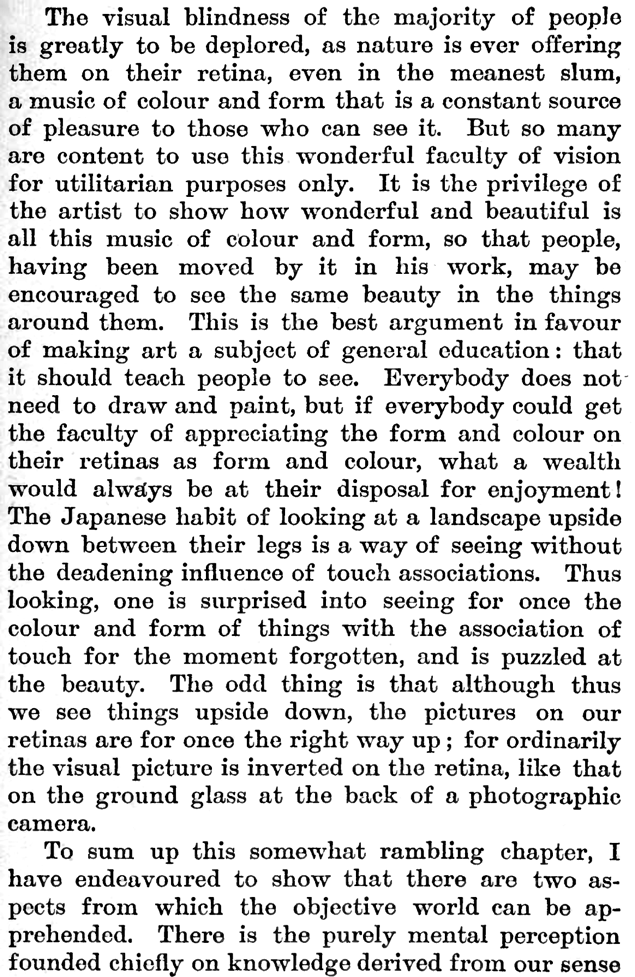
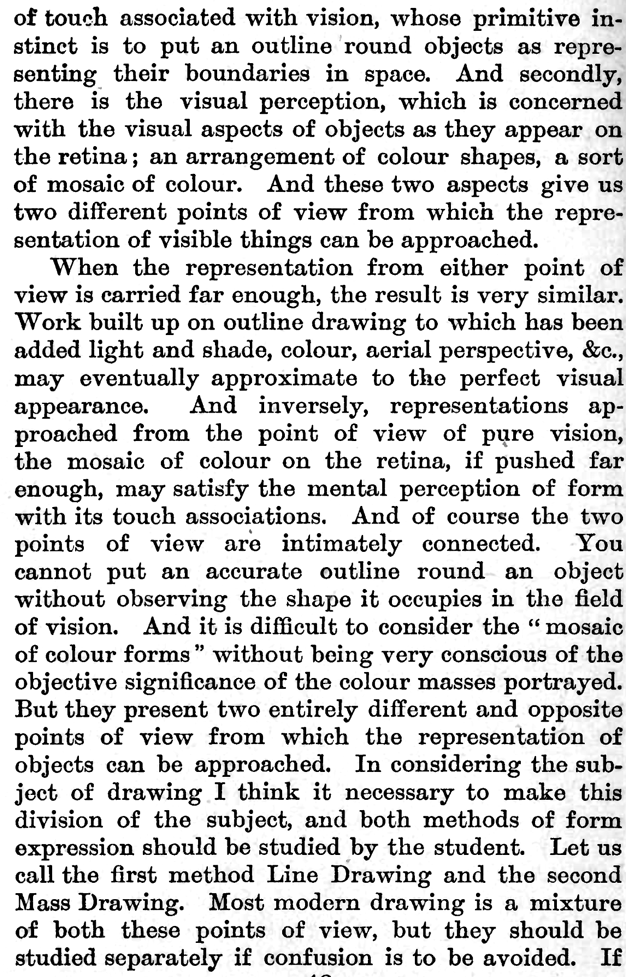

If your some reason you need the actual text for the images above...you can find it below
VISION
It is necessary to say something about Vision in the first place, if we are to have any grasp of the idea of form.
An act of vision is not so simple a matter as the student who asked her master if she should " paint nature as she saw nature " would seem to have thought. And his answer, " Yes, madam, provided you don't see nature as you paint nature," expressed the first difficulty the student of painting has to face : the difficulty of learning to see.
Let us roughly examine what we know of vision. Science tells us that all objects are made visible to us by means of light ; and that white light, by which we see things in what may be called their normal aspect, is composed of all the colors of the solar spectrum, as may be seen in a rainbow ; a phenomenon caused, as everybody knows, by the sun's rays being split up into their component parts.
This light travels in straight lines and, striking objects before us, is reflected in all directions. Some of these rays passing through a point situated behind the lenses of the eye, strike the retina. The multiplication of these rays on the retina produces a picture of whatever is before the eye, such as can be seen on the ground glass at the back of a photographer's camera, or on the table of a camera obscura, both of which instruments are constructed roughly on the same principle as the human eye.
These rays of light when reflected from an object, and again when passing through the atmosphere, undergo certain modifications. Should the object be a red one, the yellow, green, and blue rays, all, in fact, except the red rays, are absorbed by the object, while the red is allowed to escape. These red rays striking the retina produce certain effects which convey to our consciousness the sensation of red, and we say "That is a red object." But there may be particles of moisture or dust in the air that will modify the red rays so that by the time they reach the eye they may be somewhat different. This modification is naturally most effective when a large amount of atmosphere has to be passed through, and in things very distant the color of the natural object is often entirely lost, to be replaced by atmospheric colors, as we see in distant mountains when the air is not perfectly clear. But we must not stray into the fascinating province of color.
What chiefly concerns us here is the fact that the pictures on our retinas are flat, of two dimensions, the same as the canvas on which we paint. If you examine these visual pictures without any prejudice, as one may with a camera obscura, you will see that they are composed of masses of colour in infinite variety and complexity, of different shapes and gradations, and with many varieties of edges ; giving to the eye the illusion of nature with actual depths and distances, although one knows all the time that it is a flat table on which one is looking.
Seeing then that our eyes have only flat pictures containing two - dimension information about the
objective world, from whence is this knowledge of distance and the solidity of things ? How do we see the third dimension, the depth and thickness, by means of flat pictures of two dimensions ?
The power to judge distance is due principally to our possessing two eyes situated in slightly different positions, from which we get two views of objects, and also to the power possessed by the eyes of focusing at different distances, others being out of focus for the time being. In a picture the eyes can only focus at one distance (the distance the eye is from the plane of the picture when you are looking at it), and this is one of the chief causes of the perennial difficulty in painting backgrounds. In nature they are out of focus when one is looking at an object, but in a painting the background is necessarily on the same focal plane as the object. Numerous are the devices resorted to by painters to overcome this difficulty, but they do not concern us here.
The fact that we have two flat pictures on our two retinas to help us, and that we can focus at different planes, would not suffice to account for our knowledge of the solidity and shape of the objective world, were these senses not associated with another sense all important in ideas of form, the sense of touch.
This sense is very highly developed in us, and the earlier period of our existence is largely given over to feeling for the objective world outside ourselves. Who has not watched the little baby hands feeling for everything within reach, and without its reach, for the matter of that ; for the infant has no knowledge yet of what is and what is not within its reach. Who has not offered some bright object to a young child and watched its clumsy attempts to feel for it, almost as clumsy at first as if it were blind as it has not yet learned to focus distances. And when he has at last got hold of it, how eagerly he feels it all over, looking intently at it all the time ; thus learning early to associate the " feel of an object" with its appearance. In this way by degrees he acquires those ideas of roughness and smoothness, hardness and softness, solidity, &etc., which later on he will be able to distinguish by vision alone, and without touching the object.
Our survival depends so much on this sense of touch, that it is of the first importance to us. We must know whether the ground is hard enough for us to walk on, or whether there is a hole in front of us ; and masses of colour rays striking the retina, which is what vision amounts to, will not of themselves tell' us. But associated with the knowledge accumulated in our early years, by connecting touch with sight, we do know when certain combinations of color rays strike the eye that there is a road for us to walk on, and that when certain other combinations occur there is a hole in front of us, or the edge of a precipice.
And likewise with hardness and softness, the child who strikes his head against the bed-post is forcibly reminded by nature that such things are to be avoided, and feeling that it is hard and that hardness has a certain look, it avoids that kind of thing in the future. And when it strikes its head against the pillow, it learns the nature of softness, and associating this sensation with the appearance of the pillow, knows in future that when softness is observed it need not be avoided as hardness must be.
Sight is therefore not a matter of the eye alone. A whole train of associations connected with the objective world is set going in the mind when rays of light strike the retina refracted from objects. And these associations vary enormously in quantity and value with different individuals ; but the one we are here chiefly concerned with is this universal one of touch. Everybody " sees " the shape of an object, and " sees" whether it "looks " hard or soft, &etc Sees, in other words, the " feel" of it.
If you are asked to think of an object, say a cone, it will not, I think, be the visual aspect that will occur to most people. They will think of a circular base from which a continuous side slopes up to a point situated above its center, as one would feel it. The fact that in almost every visual aspect the base line is that of an ellipse, not a circle, comes as a surprise to people unaccustomed to drawing.
But above these cruder instances, what a wealth of associations crowd in upon the mind, when a sight that moves one is observed. Put two men before a scene, one an ordinary person and the other a great poet, and ask them to describe what they see. Assuming them both to be possessed of a reasonable power honestly to express themselves, what a difference would there be in the value of their descriptions. Or take two painters both equally gifted in the power of expressing their visual perceptions, and put them before the scene to paint it. And assuming one to be a commonplace man and the other a great artist, what a difference will there be in their work. The commonplace painter will paint a commonplace picture, while the form and color will be the means of stirring deep associ ations and feelings in the mind of the other, and will move him to paint the scene so that the same splendor of associations may be conveyed to the beholder.
Plate VII
STUDY FOR THE FIGURE OF APOLLO IN THE PICTURE
"APOLLO AND DAPHNE '7
But to return to our infant mind. While the development of the perception of things has been going on, the purely visual side of the question, the observation of the picture on the retina for what it is as form and color, has been neglected—neglected to such an extent that when the child comes to attempt drawing, sight .is not the sense he consults. The mental idea of the objective world that has grown up in his mind is now associated more directly with touch than with sight, with the felt shape rather than the visual appearance. So that if he is asked to draw a head, he thinks of it first as an object having a continuous boundary in space. This his mind instinctively conceives as a line. Then, hair he expresses by a row of little lines coming out from the boundary, all round the top. He thinks of eyes as two points or circles, or as points in circles, and the nose either as a triangle or an L-shaped line. If you feel the nose you will see the reason of this. Down the front you have the L line, and if you feel round it you will find the two sides meeting at the top and a base joining them, suggesting the triangle. The mouth similarly is an opening with a row of teeth, which are generally shown although so seldom seen, but always apparent if the mouth is felt (see diagram A). This is, I think, a fair typo of the first drawing the ordi nary child makes—and judging by some ancient scribbling of the same order I remember noticing scratched on a wall at Pompeii, and by savage drawing generally, it appears to be a fairly universal
type. It is a very remarkable thing which, as far as I know, has not yet been pointed out, that in these first attempts at drawing the vision should not be consulted. A blind man would not draw differently, could he but see to draw. Were vision the first sense consulted, and were the simplest visual
Diagram I
-
TYPE OF FIRST DRAWING MADE BY CHILDREN, SHOWING HOW VISION HAS NOT BEEN CONSULTED
-
TYPE OF WHAT MIGHT HAVE BEEN EXPECTED IF CRUDEST EXPRESSION OF VISUAL APPEARANCE HAD BEEN ATTEMPTED
appearance sought after, one might expect something like diagram B, the shadows under eyes, nose, mouth, and chin, with the darker mass of the hair being the simplest thing the visual appearance can be reduced to. But despite this being quite as easy to do, it does not appeal to the ordinary child as the other type does, because it does not satisfy the sense of touch that forms so large a part of the idea of an object in the mind. All architectural elevations and geometrical projections generally appeal to this mental idea of form. They consist of views of a building or object that could never possibly be seen by anybody, assuming as they do that the eye of the spectator is exactly in front of every part of the building at the same time, a physical impossibility. And yet so removed from the actual visual appearance is our mental idea of objects that such drawings do convey a very accurate idea of a building or object. And of course they have great advantage as working drawings in that they can be scaled.
If so early the sense of vision is neglected and relegated to be the handmaiden of other senses, it is no wonder that in the average adult it is in such a shocking state of neglect. I feel convinced that with the great majority of people vision is seldom if ever consulted for itself, but only to minister to some other sense. They look at the sky to see if it is going to be fine ; at the fields to see if they are dry enough to walk on, or whether there will be a good crop of hay ; at the stream not to observe the beauty of the reflections from the blue sky or green fields dancing upon its surface or the rich coloring of its shadowed depths, but to calculate how deep it is or how much power it would supply to work a mill, how many fish it contains, or some other association alien to its visual aspect. If one looks up at a fine mass of cumulus clouds above a London street, the ordinary passer-by who follows one's gaze expects to see a balloon or a flying-machine at least, and when he sees it is only clouds he is apt, to wonder what one is gazing at. The beautiful form and color of the cloud seem to be unobserved. Clouds mean nothing to him but an accumulation of water dust that may bring rain. This accounts in some way for the number of good paintings that are incomprehensible to the majority of people. It is only those pictures that pursue the visual aspect of objects to a sufficient completion to contain the suggestion of these other associations, that they understand at all. Other pictures, they say, are not finished enough. And it is so seldom that a picture can have this petty realization and at the same time be an expression of those larger emotional qualities that constitute good painting.
The early paintings of the Pre-Raphaelite Brotherhood appear to be a striking exception to this. But in their work the excessive realization of all details was part of the expression and gave emphasis to the poetic idea at the basis of their pictures, and was therefore part of the artistic intention. In these paintings the fiery intensity with which every little detail was painted made their picture a ready medium for the expression of poetic thought, a sort of "painted poetry," every detail being selected on account of some symbolic meaning it had, bearing on the poetic idea that was the object of the picture.
But to those painters who do not attempt " painted poetry," but seek in painting a poetry of its own, a visual poetry, this excessive finish (as it is called) is irksome, as it mars the expression of those qualities in vision they wish to express. Finish in art has no connection with the amount of detail in a picture, but has reference only to the completeness with which the emotional idea the painter set out to express has been realized.
The visual blindness of the majority of people is greatly to be deplored, as nature is ever offering them on their retina, even in the meanest slum, a music of color and form that is a constant source of pleasure to those who can see it. But so many are content to use this wonderful faculty of vision for utilitarian purposes only. It is the privilege of the artist to show how wonderful and beautiful is all this music of color and form, so that people, having been moved by it in his work, may be encouraged to see the same beauty in the things around them. This is the best argument in favor of making art a subject of general education : that it should teach people to see. Everybody does not-need to draw and paint, but if everybody could get the faculty of appreciating the form and color on their retinas as form and color, what a wealth would always be at their disposal for enjoyment The Japanese habit of looking at a landscape upside down between their legs is a way of seeing without the deadening influence of touch associations. Thus looking, one is surprised into seeing for once the color and form of things with the association of touch for the moment forgotten, and is puzzled at the beauty. The odd thing is that although thus we see things upside down, the pictures on our retinas are for once the right way up ; for ordinarily the visual picture is inverted on the retina, like that on the ground glass at the back of a photographic camera.
To sum up this somewhat rambling chapter, I have endeavored to show that there are two as poets from which the objective world can be apprehended. There is the purely mental perception founded chiefly on knowledge derived from our sense of touch associated with vision, whose primitive instinct is to put an outline round objects as representing their boundaries in space. And secondly, there is the visual perception, which is concerned with the visual aspects of objects as they appear on the retina ; an arrangement of color shapes, a sort of mosaic of color. And these two aspects give us two different points of view from which the representation of visible things can be approached.
When the representation from either point of view is carried far enough, the result is very similar. Work built up on outline drawing to which has been added light and shade, color, aerial perspective, &etc, may eventually approximate to the perfect visual appearance. And inversely, representations approached from the point of view of pure vision, the mosaic of color on the retina, if pushed far enough, may satisfy the mental perception of form with its touch associations. And of course the two points of view are intimately connected. You cannot put an accurate outline round an object without observing the shape it occupies in the field of vision. And it is difficult to consider the " mosaic of color forms" without being very conscious of the objective significance of the color masses portrayed. But they present two entirely different and opposite points of view from which the representation of objects can be approached. In considering the subject of drawing I think it necessary to make this division of the subject, and both methods of form expression should be studied by the student. Let us call the first method Line Drawing and the second Mass Drawing. Most modern drawing is a mixture of both these points of view, but they should be studied separately if confusion is to be avoided. If the student neglects line drawing, his work will lack the expressive significance of form that only a feeling for lines seems to have the secret of conveying ; while, if he neglects mass drawing, he will be poorly equipped when he comes to express form with a brush full of paint to work with.
Privacy Policy ...... Contact Us




